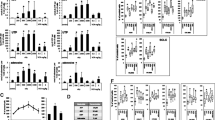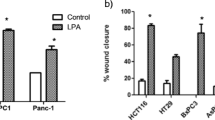Until recently, the signal transduction pathways involved in the processes of tumor growth have been poorly understood. In the present study, we investigated cell surface receptors which utilize phosphatidylinositol (Pl) turnover/Ca2+ mobilization as a signal transduction pathway to regulate cell growth in a metastatic human lung carcinoma cell line, PG. We found that purinoceptor agonists, including ATP and its analogs, and bombesin, an amphibian tetradeca-peptide of mammalian homology gastrin-releasing peptide, induced rapid transient increase of cytoplasmic-free Ca2+ in PG cells loaded with fura-2. The Ca 2+ responses were derived both from release from internal stores and the opening of plasma membrane Ca 2+ channels. HPLC analysis of inositol 1,4,5-triphosphate (Ins(1,4,5)P3) and its isomers showed a receptor-linked phospholipase C activation by ATP and bombesin. Although ATP and bombesin were both able to induce PI turnover and Ca2+ mobilization in PG cells, they had differential growth regulatory effects on PG cells. Treatment with bombesin stimulated PG cell growth while treatment with ATP inhibited significantly PG cell growth. Pharmacological studies showed that the purinoceptors on PG cells were of the P2 subtype. Other hydrolysis-resistant P2 purinoceptor agonists, including ATPγS and AMP-PNP, were as effective as ATP in stimulating PI turnover and Ca2+ mobilization as well as in inhibiting PG cell growth in vitro, suggesting the potential usefulness of such ATP analogs in clinical trials. Preliminary results suggest G protein involvement in the differential regulation of ATP and bombesin signal transduction pathways.
Similar content being viewed by others
References
Rozengurt E, 1986, Early signals in mitogenic response. Science, 234, 161–166.
Druker BJ, Mamon HJ and Roberts TM, 1989, Oncogenes, growth factors, and signal transduction. New England Journal of Medicine, 16, 1383–1391.
Fang W-g and Wu B-q. Induction of metastatic phenotype in NIH/3T3 cells transfected with DNA from a metastatic tumor cell line. In Wu B-Q and Zheng J, eds. Immune-deficient Animals in Experimental Medicine, pp. 112–117. Basel: Karger, 1989.
Wu B-q, Sun Y-K, Zheng J, Fang W-g and Wang J-l. Metastatic behaviour of cultured human lung carcinoma lines in nude mice. In Rygaard J, Brunner N, Graem N and Spang-Thomsen M, eds. Immune-deficient Animals in Biomedical Research, pp. 290–302. Basel: Karger, 1987.
Tsien RY, Pozzan T and Rink TJ, 1982, Calcium homeostasis in intact lymphocytes: cytoplasmic free calcium monitored by a new intracellularly trapped fluorescent indicator. Journal of Cellular Biology, 94, 325–334.
Grynkiewicz G, Poenie M and Tsien RY, 1985, A new generation of Ca2+ indicators with greatly improved fluorescence properties. Journal of Biological Chemistry, 260, 3440–3450.
Mosmann T, 1983, Rapid colorimetric assay for cellular growth and survival: application to proliferation and cytotoxicity assays. Journal of Immunological Methods, 65, 55–63.
Gordon JL, 1986, Extracellular ATP: effects, sources and fate. Biochemistry Journal, 233, 309–319.
Rana RS and Hokins LE, 1990, The role of phosphoinositides in transmembrane signaling. Physiological Review, 70, 115–164.
Berridge MJ and Irvine RF, 1989, Inositol phosphates and cell signaling. Nature, 341, 197–205.
Dubyak GR and Fedan JS, 1990, The biological actions of extracellular adenosine triphosphate. Comprehensive Therapy, 16, 57–61.
Huang N, Wang D and Heppel CA, 1989, Extracellular ATP is a mitogen for 3T3, 3T6, and A431 cells and acts synergistically with other growth factors. Proceedings of the National Academy of Science, USA, 86, 7904–7908.
Filippini A, Taffs RE and Sitkovsky MV, 1990, Extracellular ATP in T-lymphocyte activation: possible role in effector functions. Proceedings of the National Academy of Science, USA, 87, 8267–8271.
Rapaport E and Fontaine J, 1989, Anticancer activities of adenosine nucleotides in mice are mediated through expansion of erythrocyte ATP pools. Proceedings of the National Academy of Science, USA, 86, 1662–1666.
Fang W-g, Pirnia F, Bang YJ, Myers CE and Trepel J, 1992, P2 purinergic receptor agonists inhibit the growth of androgen-independent prostate carcinoma cells. Journal of Clinical Investigation, 89, 191–196.
Orrenius S, McConkey DJ, Bellomo G and Nicotera P, 1989, Role of Ca2+ in toxic cell killing. Trends in Pharmacological Science, 10, 281–285.
Nicotera P, McConkey DJ, Svensson SA, Bellomo G and Orrenius S, 1988, Correlation between cytosolic Ca2+ concentration and cytotoxicity in hepato cytes exposed to oxidative stress. Toxicology, 52, 55–63.
Birmbaumer L, 1990, G proteins in signal transduction. Annual Review on Pharmacological Toxicology, 30, 675–705.
Ashkenazi A, Peralta EG, Winslow JW, Ramachandran J and Capon DJ, 1989, Functionally distinct G proteins selectively couple different receptors to Pl hydrolysis in the same cell. Cell, 56, 487–493.
Author information
Authors and Affiliations
Rights and permissions
About this article
Cite this article
Fang, Wg., Wu, Bq. Differential growth regulation of a metastatic human lung carcinoma cell line through activation of phosphatidyl inositol turnover signal transduction pathway. Clin Exp Metast 11, 330–336 (1993). https://doi.org/10.1007/BF00058053
Received:
Accepted:
Issue Date:
DOI: https://doi.org/10.1007/BF00058053




